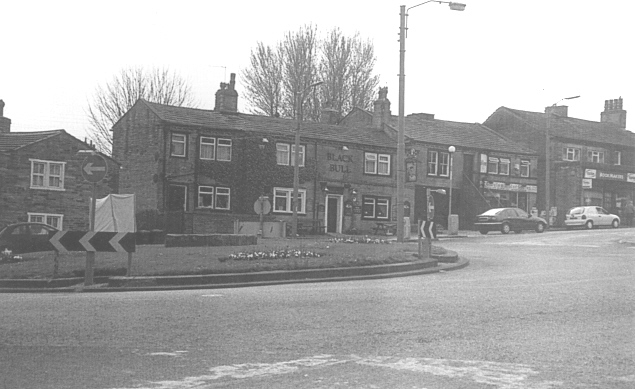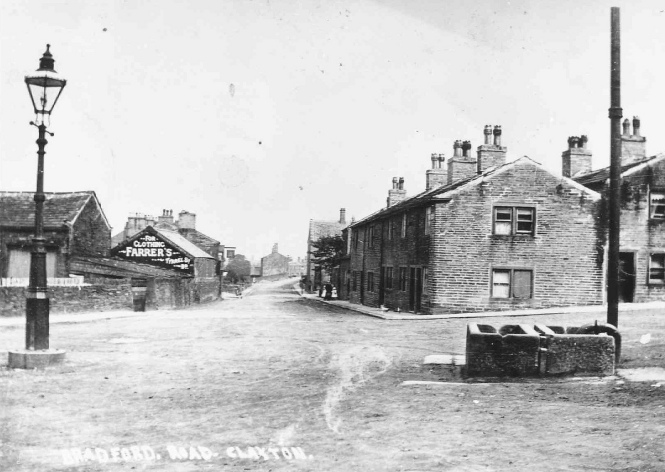Clayton was ancient settlement and was mentioned in the Domesday Book. It was part of the Manor of Bolton, under the control of Ilbert de Lacy. At that time it was known as ‘Claitone’, meaning ‘clay soil’. When Clayton ceased to he part of the Manor of Bolton, it was split into three parts: Clayton Village, Clayton Heights and Cockan, a now non-existent village which lay to the southwest of the present village.
Between 1160 and 1316, Clayton belonged to the following Lords of the Manor: Hugh Stapleton, William de Stapleton, Jordan de Birill and Hugh de Leaventhorpe. It was then acquired by the Bollings in 1324. The Bolling family. and their successors the Tempests, held the Manor of Clayton for nearly 300 years, until it descended to the Lacies of Cromwell – Bottom by marriage. After the Lacies sold the manor around 1740, it passed through many hands until 1894, when the district council was formed. The council fought off an attempt by Bradford Corporation in 1898 to amalgamate Clayton with the city of Bradford, and for many years the villagers enjoyed their independence. Inevitably though, in 1930, Clayton finally become part of the city of Bradford, much to the reluctance of many of the residents.
Up until the end of the 19th century, Clayton was almost all green land with very few buildings indeed. Looking at maps from 1893, it was only a very small village surrounded by fields. In the early 20th century much development took place but the village still had its green belt surrounding it. Even today, Clayton is separated from its nearest neighbours by fields. It must be a ramblers’ paradise. One can walk to Thornton. Queensbury and even Ogden reservoir through the fields and across moors.
Prior to 1878, when the railway station opened, the only means of transport to and from the village would have been by foot or horse. The station was on the Bradford, Halifax and Keighley branch of the Great Northern Railway, and was situated on Pasture Lane. This meant that it was only 12 minutes to Bradford via rail and only 23 minutes to Halifax. Quicker than driving today it seems. The branch line Closed in 1955 and the entrance to the Queensbury Tunnel was blocked and sealed up.
The railway might have mode it easier for residents to leave the village, but there was not actually much need for this. Clayton was quite self-sufficient. Many shops had opened in the Clayton Lane area. In 1900 there was a draper, grocers, newsagent. shoemaker, beer retailer, butcher, milliner, confectioner, builder and even a clogger.
One of the focal points of todays village is Victoria Park. The park actually originates from the old village green. In 1897, a meeting of residents was held at which it was proposed that the village green and surrounding land be purchased to form a park. It was suggested that the park be created for Clayton residents to use forever, and donations were collected so that the project could succeed without any cost to ratepayers, although the park’s upkeep would be paid for by the rates. The scheme was started in commemoration of the Diamond Jubilee of Queen Victoria and the park finally opened on 23 July 1898. It was opened by Asa Briggs, the highly respected Clayton philanthropist.
The roundabout in Clayton is home to the “wells”. The wells were stone troughs which supplied water in days gone by. Householders without water supply would bring their own buckets here to fill up, and carters on their way to Queensbury or Thornton would stop here to let their horses drink. The area was a popular meeting place in times past.
One of Clayton’s biggest claims to fame is that it was the birthplace and home of Albert Pierrepoint, Britain’s last ‘Number One’ official hangman. In his role as state executioner Pierrepoint dispatched some of the country’s most notorious convicted murderers – while expressing some personal reservations about the value and use of capital punishment.
Alfred Wallis was a well-known and respected Claytonian. He started business in Oak Mills in 1860, with Asa Briggs and Joseph Benn. He was active in Clayton’s affairs for many years and he set up the Alfred Wallis Trust Fund, which can still be used today for the further education of Clayton’s young people. Another of the area’s characters was known as the ‘Clayton poet’. Sherwin Stephenson was born in the village in 1881. He became a talented poet, describing his experiences and life in Clayton. He penned such verses as; `Bonny Clayton’, `Teah Pot Spaht’, ‘The Old Brewery, Clayton’, ‘Cote Fields’ and ‘My Native Hills’, all celebrating the people and surroundings of Clayton. He even described the wells as a meeting place of the ‘Clayton Parliament’. A true ambassador for the village, Sherwin died in 1954. He is buried in Clayton churchyard, where his headstone resembles an open book.
Stephenson’s poems are a perfect reminder of how Clayton used to be. The village will never be the same again, but it is one of the few areas of Bradford which has retained its character somewhat. Stephenson would be proud.



Does anyone have the words to the Bonny Clayton poem? My dad recently passed away and he was born and raised in Clayton and I’m looking for something to add to the memorial service which relates to his home village. Thanks in anticipation.
LikeLike
Hi Mike. Please email local.studies@bradford.gov.uk who may be able to assist.
LikeLike
46 years ago I lived in Clayton..Sandringham Rd… It has always been a good community village.
Still visit from time to time and always have a good night in the village pubs.
LikeLiked by 1 person
i was born in clayton in 1936 my brother in 1926 my father was born here he lived up ramsden place with his mother and father my father had electrical shops in clayton on green end opp the black bull pub in late 40s to 50 i still live in clayton i love it
LikeLiked by 1 person
I wasn’t born in Clayton but went to Clayton school and a great time there I also had lots of friends and as boy played around Clayton. I lived in Clayton at the back of the park. Now I live in Thornton but still drink there in Clayton it will always be apart of me.
LikeLiked by 1 person
I love Clayton Village, I have family there and lived there myself until leaving 21 years ago to live in Florida, I have returned to Clayton for the last 4 years for whats now is my number one vacation spot, I hope to return for good one day, its where my heart is.
LikeLiked by 1 person
This was such a nice read of Clayton which has a special place in my heart where I was born and spent my youth and went to all the Clayon schools , till I met the man of my dreams and was whisked away to Great Yarmouth where I have lived for nearly 40 years but Clayton will always be home and to read its history is something special xxx Julie Staff…used to be Delaney
LikeLiked by 1 person